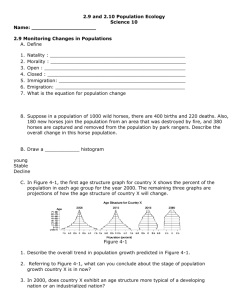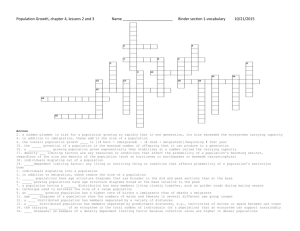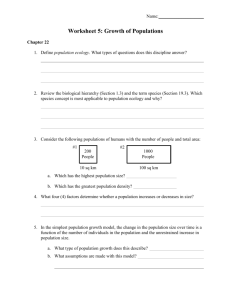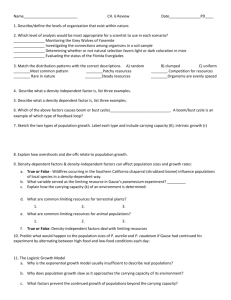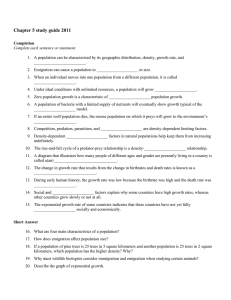Populations Practice Worksheet: Density & Growth Curves
advertisement
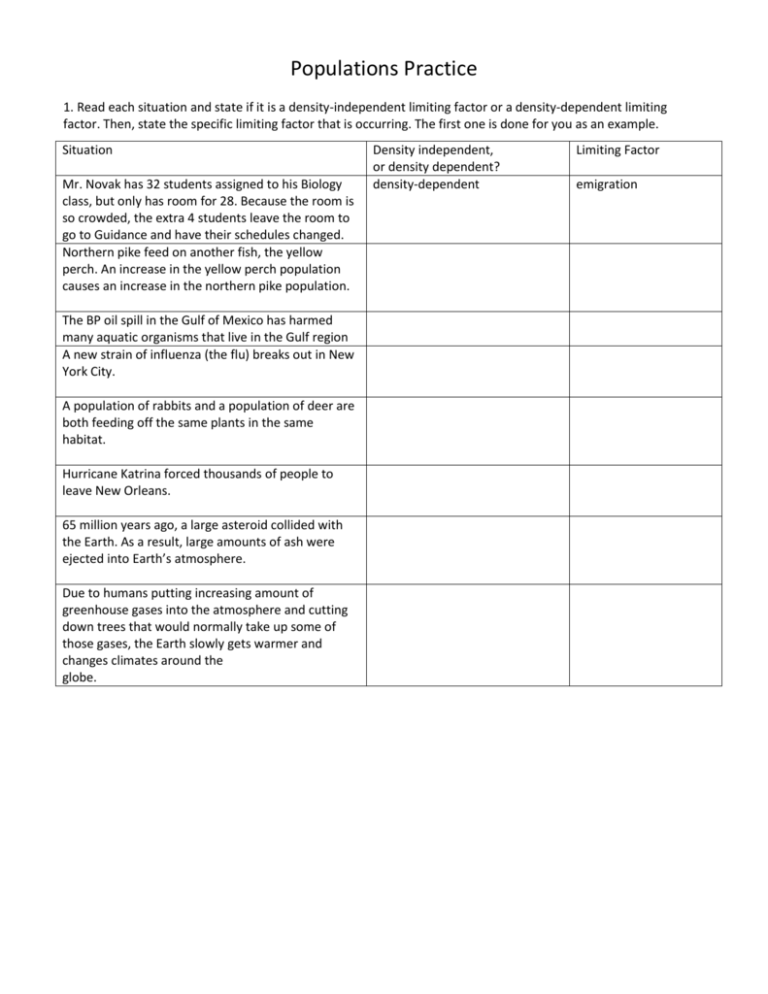
Populations Practice 1. Read each situation and state if it is a density-independent limiting factor or a density-dependent limiting factor. Then, state the specific limiting factor that is occurring. The first one is done for you as an example. Situation Mr. Novak has 32 students assigned to his Biology class, but only has room for 28. Because the room is so crowded, the extra 4 students leave the room to go to Guidance and have their schedules changed. Northern pike feed on another fish, the yellow perch. An increase in the yellow perch population causes an increase in the northern pike population. The BP oil spill in the Gulf of Mexico has harmed many aquatic organisms that live in the Gulf region A new strain of influenza (the flu) breaks out in New York City. A population of rabbits and a population of deer are both feeding off the same plants in the same habitat. Hurricane Katrina forced thousands of people to leave New Orleans. 65 million years ago, a large asteroid collided with the Earth. As a result, large amounts of ash were ejected into Earth’s atmosphere. Due to humans putting increasing amount of greenhouse gases into the atmosphere and cutting down trees that would normally take up some of those gases, the Earth slowly gets warmer and changes climates around the globe. Density independent, or density dependent? density-dependent Limiting Factor emigration 2. Growth curves a. Which type of population growth appears to continue unchecked? b. What causes the population to slow down during logistic growth? c. The maximum population an environment can sustain is affected by environmental factors that cause the population to level out or become stable. What term is used to describe this level of logistic growth? d. Propose some reasons why population growth is so rapid immediately after the lag phase in both diagrams? e. Exponential growth (diagram A) refers to the phenomena of populations that double in size every generation. If you start with a single bacterium capable of dividing every 20 minutes, how many bacteria would you have after just four hours? f. In most natural populations rapid exponential growth is unsustainable. As populations increase, environmental resistance causes the growth rate to slow down, until carrying capacity is reached. With your group, brainstorm several factors that could be considered as environmental resistance. g. Diagram B shows that the population size fluctuates around the carrying capacity. Considering what you know about interactions in the environment, discuss with your group some of the factors that could cause these fluctuations. In your answer you should relate these factors to the information from Model 1. 3. Growth curves Graph I shows the growth curve for a culture of Paramecium aurelia, a type of microscopic, unicellular protist. Graph II shows the growth curve for a culture of Paramecium caudatum, a larger species of the same protist. Graph III shows the growth curves of both species when they are grown together. a. What type of population growth is shown in Graphs I and II, when each protist is in its own jar? Explain how you know: b. Study Graph III (the bottom graph) very carefully. It shows what happens when you put both populations of paramecia in the same jar. Why did the population of P. caudatum decrease, but the population of P. aurelia increase? c. Look at your answer above. Go back and add if what occurred was a density independent limiting factor, or a density-dependent limiting factor. Then, explain why it is the factor you chose. 4. Population pyramids a. In Mexico, what percentage of the population is between 0-4 years of age? _______ In the US? ______ b. Which population is growing the fastest? ________ c. Which age group has the smallest number in both countries? _____ 5. Human growth curves a. Which country looks like it is experiencing exponential growth? ___________________ b. Which country looks like it has reached its carrying capacity? _______________________ c. Because it has reached its carrying capacity, describe the relationship between its birth rates and death rates in the space below: d. Describe what is happening to Europe’s population size in terms of birth rates and death rates. e. Which country or countries could be experiencing emigration? Explain your answers: f. Which country or countries could be experiencing immigration? Explain your answers:

